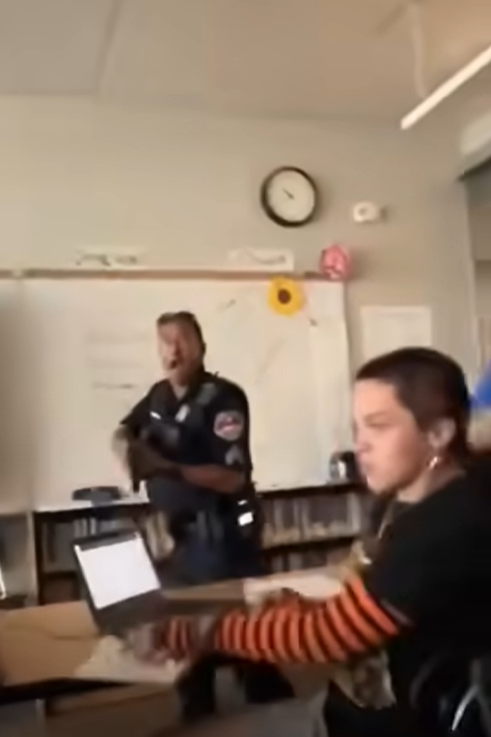Introduction
Schools have long been regarded as sanctuaries of learning, spaces where children grow intellectually, emotionally, and socially. Parents send their children each day with the expectation that classrooms will nurture curiosity rather than fear. Yet, recent events have shaken that sense of safety. Across the United States, rising concerns about weapons on campus, bullying, and mental health challenges have fueled heated debates about how schools should balance education with security.
One incident in particular captured the nation’s attention when a viral video showed a school resource officer (SRO) pointing a firearm at a teenage student suspected of carrying a gun. The student, only sixteen years old, was eventually detained without harm, and a weapon was recovered. However, the image of a uniformed officer aiming a gun in a crowded school hallway ignited fierce discussions.
Was this an example of necessary heroism, or a dangerous overreaction that could have ended in tragedy?
This article examines the confrontation, its aftermath, and the broader questions it raises about safety, policing, and student well-being.
The Confrontation: A Moment Caught on Camera
The video, filmed by another student, begins abruptly. The school hallway is bustling with activity until the tense moment when the officer confronts the teenager. With his weapon drawn, the officer issues commands: “Get on the ground.”
The student, visibly unsettled, resists. Instead of immediately complying, he responds with, “Why? What do you want me on the ground for?” His hesitation, captured from multiple angles by classmates’ phones, sends shockwaves through the room.
Students scatter. Some run for cover, while others—like countless teenagers in the digital age—lift their phones to record.
According to official reports, school administrators had received credible information that the student might be armed. The officer, trained to act decisively in such scenarios, drew his firearm as a precaution. When the situation ended, a weapon was indeed found in the teenager’s possession.
No shots were fired. No one was physically harmed. Yet the psychological impact was undeniable.
Immediate Aftermath: Relief and Trauma
After the incident, the school immediately activated its emergency protocols:
Teachers locked classroom doors and sheltered students inside.
Parents were notified via automated calls and emails.
Police presence increased around campus.
Counselors and crisis response teams were made available.
The student was taken into custody and now faces charges of unlawful possession of a firearm on school grounds.
For many parents, the news was a mix of relief and alarm. Relief that the situation ended without bloodshed—but alarm that such a situation had occurred at all.
One parent expressed the tension clearly:
“I’m grateful no one was hurt, but it terrifies me that my child’s school is a place where guns and police confrontations are even possible.”
Students’ Mixed Reactions
For the students who lived through the moment, emotions were complex. Some said they felt reassured, believing the officer’s quick action may have prevented tragedy. Others described being traumatized, saying the sight of a gun inside their school made them question whether they were truly safe.
A junior student recalled:
“I couldn’t focus in class after that. Every time I heard the hallway doors slam, I jumped. It’s hard to feel like school is just school anymore.”
This incident highlighted not only the immediate danger of firearms but also the long-lasting psychological scars left on students, many of whom may carry this fear with them for years.
Educators and Community Leaders Weigh In
Local educators and officials voiced strong but divided opinions.
Supporters of the officer’s actions argued that swift, decisive action was necessary. A firearm was recovered, after all. “Better to be safe than sorry” was the common refrain.
Critics of the response contended that drawing a weapon in a crowded hallway created unnecessary risk. They worried that one wrong move—an accidental discharge, a panicked reaction—could have resulted in catastrophic loss of life.
Mental health advocates emphasized prevention over reaction, stressing that schools should invest more in counseling, mentorship, and community support rather than relying solely on armed officers.
The clash of perspectives underscored a broader societal divide about how to approach safety in schools.
The Debate Over Police in Schools
The incident reignited the ongoing national debate about the role of police officers in educational environments.
Arguments for School Resource Officers (SROs)
Deterrence: Visible law enforcement presence discourages students from bringing weapons or engaging in violence.
Rapid Response: In emergencies, on-site officers can act in seconds rather than waiting for outside responders.
Mentorship: Some SRO programs emphasize relationship-building, where officers act as mentors and positive role models.
Arguments Against SROs
Escalation: Critics argue that introducing weapons and authority figures increases the potential for conflict rather than reducing it.
Disproportionate Impact: Research shows that students of color are disproportionately disciplined or criminalized in schools with heavy police presence.
Psychological Climate: Many students report feeling less safe, not more, when armed officers patrol hallways daily.
This tug-of-war is not new. However, the viral video pushed the issue back into national headlines, reminding communities that the debate is far from resolved.
A Troubling National Trend: More Guns on Campus
The high school confrontation is not an isolated case. Across the country, reports of firearms discovered on school grounds are on the rise.
Contributing factors include:
Easier access to firearms in homes.
Broader community violence spilling over into schools.
Rising mental health struggles among youth.
Influence of social media challenges that sometimes glorify risky behavior.
In 2024 alone, dozens of school districts reported students caught with weapons. While not all led to confrontations, each discovery raises the same chilling question: Why are more young people bringing guns into places of learning?
Psychological Impact: Beyond Physical Safety
Even though the incident ended without bloodshed, the emotional toll was immense. Students exposed to violent or high-stakes situations often develop:
Heightened anxiety about attending school.
Difficulty concentrating, leading to academic setbacks.
Distrust of authority, including teachers and police officers.
Lingering trauma, requiring professional mental health support.
Parents and educators now face the challenge of rebuilding trust, reminding students that schools are meant to be places of safety and growth.
Legal Consequences for the Student
The teenager involved is expected to face juvenile court proceedings. Possible outcomes range from probation and counseling to more serious penalties. Regardless of the legal outcome, the case has already reshaped the community’s conversation about accountability, safety, and prevention.
What Schools Are Doing Next
In response, school administrators pledged to review existing safety measures. This includes:
Updating staff training for de-escalation strategies.
Reassessing the role of SROs in hallways.
Increasing collaboration with mental health professionals.
Expanding outreach to parents to help identify early warning signs.
Some districts nationwide are now considering hybrid approaches—keeping SROs but placing greater emphasis on student mental health and restorative justice practices.
Broader Lessons
This single event reflects the broader challenges facing American schools:
Preparedness matters: Schools need clear, practiced emergency protocols.
Prevention saves lives: Early intervention—whether through counseling or mentorship—can stop problems before they escalate.
Balance is key: Safety must be paired with a nurturing environment.
Community involvement is crucial: Parents, educators, and students should all have a say in shaping school security.
Conclusion
The viral image of a police officer pointing a gun at a teenager in a crowded high school hallway has left the nation unsettled. For some, it represents decisive action that averted potential tragedy. For others, it illustrates how easily danger can escalate when firearms are introduced into schools—even by those sworn to protect.
This case forces us to confront difficult but necessary questions:
How do we balance security with compassion?
Should armed officers be a permanent fixture in education?
What more can be done to address the root causes driving students to bring weapons into classrooms?
Ultimately, the incident reminds us that safety in schools is not just about preventing violence—it is about creating environments where children feel secure enough to learn, grow, and thrive. That balance will require collaboration, empathy, and bold solutions that go beyond fear and focus instead on building communities of trust.



